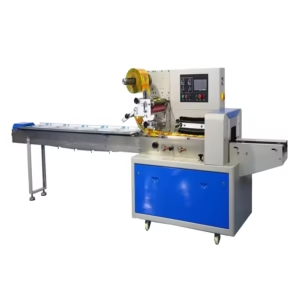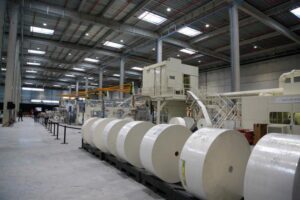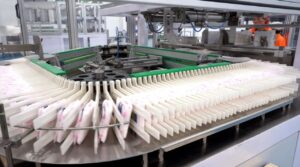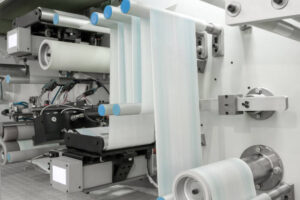Almost everywhere you sit or stand, there is a Nonwoven Fabric. A coffee filter, a teabag, a mask, diapers, eyeglass tissues, or other similar items can be used. Although the present pandemic crisis has increased the importance of this fabric, its market has grown over time.
Nonwoven fabrics are sheet or web structures that are mechanically, thermally, or chemically bound together by entangling fiber or filaments (and perforating films). They are flat, porous sheets manufactured directly from individual fibers, molten plastic, or plastic film. They aren’t manufactured by weaving or knitting, and they don’t require the fibers to be converted to yarn.
Nonwoven materials in India often have one of two textures: a dotted grid pattern or a zig-zag texture of fibres. The former is usually available in a somewhat thicker sheet, while the latter is generally accessible in a thinner density. They are either extruded or thermally bonded, and neither is woven.
Nonwovens’ properties
- The combination of components that go into making nonwovens can give them a unique set of qualities. The range is broad.
- Nonwovens can have the look of paper, felt, or something comparable to woven materials.
- They can have soft, supple hands or rigid, stiff, or practically inflexible hands.
- They can be as thin as tissue paper or as thick as it gets.
- They come in a variety of colors and can be transparent or opaque.
- The porosity of these materials ranges from low crack and breaking strength to highly tensile strength.
- They can be glued, hot glued or sewn together.
- This fabric’s draping ability ranges from good to poor.
- Some materials can be washed easily, while others can be cleaned dry.
What Are the Benefits of Non-Woven Fabrics?
Nonwoven materials are vital because they are adaptable, decomposable, versatile, and innovative. Fabric manufacture does not require yarn preparation because it is made directly from fibers. As a result, their manufacturing method is quick and straightforward.
Nonwoven fabrics are employed in various industries, including protective, geotextile, construction, filtration, automotive, fashion, and medical applications. This cloth is commonly utilized nowadays, and it appears that life would be impossible to comprehend without it. There are two sorts of this fabric: disposable and durable. Sixty percent of the fabric is stable, whereas forty percent is throwaway. The following are the characteristics of nonwoven fabric:
- Filtration
- Insulation against noise
- Insulation from the elements
- Cushioning
- Flame-resistance
- Strength and Softness
- Stretch and Resilience
- Liquid repellence is a term used to describe a substance that repels
- Sterility
- Absorbency
Nonwoven fabrics are utilized in diapers, surgical gowns, and protective garments to pack materials and cushions.
Nonwoven fabric cloth products are indispensably important
Sheets for the bed
They have a gentle touch, do not damage the table surface, are 100 percent biodegradable and environmentally friendly, are elegantly designed, hygienic, and competitively priced; these disposable goods are practical and economical.
Backings for carpets/carpets
Through proper use and deployment, nonwoven fabric cloth is ideal for increasing the structure of carpets by extending the carpet’s life, protecting the product’s integrity, and reducing the risk of meld or bacterial growth. These also facilitate installation, protect wooden surfaces, and facilitate maintenance.
Diapers
Disposable diapers have been around for a brief period. There was no substitute for diapers before they were invented. Cloth diapers do not absorb much and must be cleaned frequently.
Even though the first generation of disposable diapers was less than ideal, the new design revolutionized the “how to keep babies as fresh, comfy, dry, and clean as possible” paradigm. Disposable diapers with a colour change indicator that tells if the child is wet, a unique size design, and re-connectable type Velcro are now available from fabric producers.
Cleaning cloth for the floor
The best performance and convenience come from using a dry dusting cloth. The nonwoven fabric cloth is manufactured to the desired thickness, allowing it to conform to any surface and capture dust, grime, and hair more effectively.
Fabrics for home upholstery
For the first time, Fabric makers will create a nonwoven home product that is effective in removing dirt, dust mites, and bacteria.
Dryer sheets for laundry
Dry sheets are used by almost everyone at least once in their lives. These tough textiles are frequently antistatic and have a thin structure that can tolerate high dryer temperatures. They can also be made to emit specific softeners and scents gradually as the clothes dry.
Medical supplies and equipment
Surgical gowns, which are only worn once by surgeons and their personnel during surgeries that are typically intricate and can continue for hours, are the most striking usage of nonwoven fabric cloth in surgical operating rooms. The ability of these items to protect health care personnel from patient bodily fluids and blood has been widely proven. They’re also sterile with a high degree of certainty. Nonwoven robes, curtains, and masks, without a doubt, will considerably lower the risk of numerous infections while in the hospital. They also frequently aid in the prevention of disease spread.
Nonwoven goods that are “smart”
Why should it surprise us that nonwoven fabric cloth will soon be among them, given that we already have smartphones, TVs, and even “smart” cars? Anti-theft shutters, explosion-proof curtains, and carpets with alarm systems may be available from fabric manufacturers in the future. It’s not simply make-believe science fiction. Nonwoven technology is a no-brainer or a blank check for engineering possibilities.
Tea and coffee bags
Nonwoven technology is being extended to coffee and tea bag users as the globe evolves. These unique textiles don’t impart any flavor or odor to the valuables they transport. They can filter liquids while retaining solids, and they are relatively robust (even wet).
Wallpaper
Wallpaper has grown in popularity around the world as a result of nonwoven fabric cloth. Fabric makers utilize nonwovens in wallpaper because they don’t have seam separation concerns (like other materials used for the same role and are easier to remove than other wallpaper forms. Nonwovens are also great for properties that are in need of some TLC, as these types of wall materials offer high stability, strength, versatility, and cost-effectiveness at the outset.
Conclusion
Nonwovens are used in a range of home furnishings. Carpet underpaddings, drapery liners, ironing board pads, lamp shades, slipcovers, scrims, ticking’s, and upholstery backings are all places where nonwovens can be found, as well as more obvious places like bed sheets, bed spreads, futons, draperies, mattress covers and pads, pillows, quilts, and tablecloths.
Manufacturers have a lot of room for experimenting because nonwoven material is used in so many sections of the home. To meet the ever-changing consumer demand, the nonwovens sector will need to offer a wide range of particularly engineered home textile products.





































We Do Business On Trust.Our Nonwoven fabric Business is Built on trust. Trust starts with Transparency.
Mr.Ramniwas Garg Founder Of Favourite Group